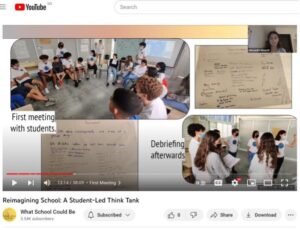Transforming School with Student Input
Last year at The Community for Learning, we asked a group of students to lead a think tank, tasked with imagining ways to revolutionize our school. We asked them to “imagine the impossible”, coming up with what they thought would be the ideal education system. Even if we couldn’t use all their ideas, we hoped they would create a vision that would inspire us to change.
(You can read more about the think tank here.)
At the end of the school year, our think tank students presented their findings to teachers and parents. Then our directors and principals spent the summer searching for ways to make several of their ideas a reality. Transforming a school is no easy task and we struggled to find ways to make this work — but here’s how we did it.
The steps we took
Among the think tank’s suggestions, there were small-ish changes — such as extending lunch hour — that we could make by adapting the schedule… but even that is not as easy as it sounds. A seemingly small change like this meant hours of brainstorming ideas about where we could find an extra 15 minutes per day for recess, without negatively impacting class time.
Some suggestions, like creating a space for our young entrepreneurs to sell their products, could easily be implemented. But other suggestions, such as getting rid of siloed subjects, seemed impossible at the moment. In our utopian vision, students would come to school for the day and study what they wanted to, when they wanted to, meeting with teachers as necessary, going off campus for projects, meeting with specialists. Thanks to university and parental expectations, we knew this vision wasn’t achievable currently. But, we asked ourselves, what could we do at the moment to move us in this direction?
Think tank students had spoken passionately about the need for multi-age learning, cross-curricular projects, and having the time and space to follow their own interests. We used these points as a springboard for the changes we could make immediately, though they would look different in elementary school than in secondary.
Changes we made in elementary
In elementary we decided to create a Passion Pursuit hour once a week, where students could work on projects they loved. This would take time away from their core subjects, but because research says happiness improves learning, we felt that allowing students to follow their passions would have positive results on their academics.
In their article “Because I’m Happy,” Victoria Jones from the Harvard Graduate School of Education writes “…from elementary school to high school, happiness is positively correlated with motivation and academic achievement.” More and more, in the American education system, schools have taken away PE and the arts in an effort to improve academics, and this has proven to be a failure. Instead, why not find ways to make education more meaningful to students? We felt that our Passion Pursuit hour would help do this.
And it did.
Changes we made in secondary
In elementary, homeroom teachers — who teach all the core subjects — have the freedom to use class time to do cross-curricular projects. However, in secondary, with its siloed subjects, this is much more difficult. Our think tank students mentioned over and over again that if we truly wanted to promote multi-age and/or cross-curricular projects, we would need to prioritize the time and space for this to happen. During remote learning, in order to lower stress, the school had given a “catch-up” day to students every two weeks. They asked us if it was possible to do something similar on campus — a day when students could work on academic or personal projects, meet with teachers for extra help, or take part in internship programs.
Once again, the first hurdle to overcome would be teachers feeling upset that time was taken from their subject areas. However, we figured that opening up this time for students to receive extra help where they needed it would actually help teachers maximize student learning. And those teachers who were eager to do collaborative projects would have the freedom to do so.
As it turned out, Project Day was a bigger success than we ever dreamed it could be.
The outcomes
Several of these changes had incredible impact: students absolutely love Passion Pursuit hours and Project Days. More and more students are coming up with small business ideas for our Entrepreneurship Fridays. Watch for upcoming blog posts that explain how we put these into practice.
Students are happy with the changes in the school, but even more importantly, they feel heard. In reflecting on the think tank project and the changes that were made this year, one of our students said, “I can’t believe the school actually listened to us and made soooo many changes. It’s awesome to see how our ideas have changed the atmosphere in the school.”
Not only did they feel heard in the school, but our think tank students were invited to share their experience with a wider audience. On Nov 30th, our students were honored to present their work on the What School Could Be, Eye on Student Protagonism series. You can see their presentation on YouTube.
Coming next— blog posts that take a deeper look at:
- Passion Pursuit hour
- Project Days
- Mixed grade level advisories
- Entrepreneurship sales



Leave a comment